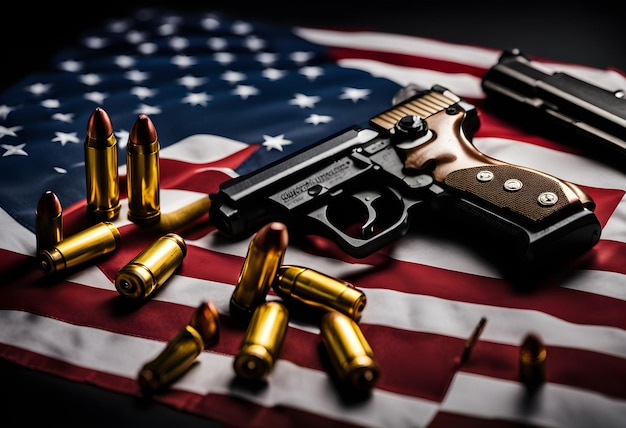SAF Sues USPS Over Gun Ban in Post Office Facilities: A Second Amendment Battle
Quick Read
SAF Sues USPS Over Gun Ban in Post Office Facilities: A Second Amendment Battle
In a significant legal challenge to the United States Postal Service (USPS) and its gun ban policy, the Second Amendment Foundation (SAF) has filed a lawsuit against the federal agency. The lawsuit, which was announced on March 16, 2023, argues that the USPS gun ban, which prohibits license holders from carrying firearms inside post offices and other postal facilities, is a clear violation of the Second Amendment rights of law-abiding citizens.
Background
The USPS gun ban has been in place since 1970, and it is enforced under the Postal Service’s weapons possession policy. This policy states that “Firearms and other dangerous or deadly weapons are prohibited in postal facilities, including parking areas, even if the individual is licensed to carry concealed firearms.” The SAF argues that this policy is not only unconstitutional but also impractical, as it leaves law-abiding citizens defenseless in situations where they may be at risk.
The Lawsuit
The SAF’s lawsuit, which was filed in the Eastern District of Pennsylvania, seeks an injunction against the USPS gun ban. The complaint argues that the policy violates the Second Amendment’s protection of the right to keep and bear arms. The SAF is represented by attorney Alan Gura, who won a landmark Second Amendment case before the Supreme Court in 2008.
Impact on Postal Workers
It’s important to note that the USPS gun ban applies not only to customers but also to postal workers. This means that postal employees who are licensed to carry firearms are prohibited from doing so while on the job, even in areas where they may be at risk. The SAF argues that this puts postal workers in an untenable position and increases the risk of harm to them and their colleagues.
Next Steps
The outcome of this lawsuit could have far-reaching implications for Second Amendment rights in the United States. The SAF is optimistic about their chances, as recent Supreme Court decisions have expanded the scope of the Second Amendment. However, the USPS may argue that postal facilities are unique environments where weapons should be prohibited for safety reasons. The case is expected to proceed through the courts over the coming months, with a potential Supreme Court appeal a distinct possibility.

Lawsuit Against USPS Gun Ban: A Second Amendment Issue
The Second Amendment of the United States Constitution is a fundamental right that protects individuals‘s ability to keep and bear arms for lawful purposes such as self-defense, hunting, and other traditional uses. This right has been the subject of much debate and legal interpretation throughout history.
Background: USPS Gun Ban Policy
In recent years, the United States Postal Service (USPS) implemented a gun ban policy that prohibits employees from carrying firearms on USPS property, even if they have concealed carry permits. This policy, some argue, infringes upon the rights of law-abiding citizens to bear arms for self-defense while at work or when using USPS services.
The Second Amendment Foundation’s (SAF) Legal Challenge
In response to this policy, the Second Amendment Foundation (SAF), a non-profit organization dedicated to defending the Second Amendment, filed a lawsuit against USPS in March 202The SAF argues that the gun ban policy violates the constitutional rights of its employees and visitors, as well as several federal and state laws.
Legal Arguments: Violations of the Second Amendment
The SAF’s complaint asserts that the USPS gun ban policy: (1) infringes on the constitutional right to keep and bear arms for self-defense without due process of law, (2) violates the Americans with Disabilities Act by denying reasonable accommodations for individuals with disabilities who require firearms for self-defense, and (3) conflicts with various state laws recognizing the right to bear arms on private property.
Conclusion: A Continued Battle for Constitutional Rights
The outcome of this lawsuit could set a significant legal precedent regarding the application of the Second Amendment in modern society and the balance between individual rights and government regulations. Stay tuned for updates on this evolving story.
The Legal Basis for the Lawsuit: The Second Amendment and Public Carry
The Second Amendment, a part of the Bill of Rights in the United States Constitution, safeguards the right to keep and bear arms. The historical context of this amendment is deeply rooted in the Founding Fathers’ belief that a well-regulated militia, composed of the citizenry itself, was crucial for maintaining liberty and security. In recent decades, the debate over the scope of this right has intensified, particularly in relation to public carry.
Relevant Supreme Court Cases:
The interpretations of the Second Amendment have been shaped by several significant Supreme Court cases. In 2008, the landmark decision in link recognized an individual right to possess a firearm for lawful purposes, such as self-defense within the home. A few years later, in 2010, the Supreme Court further clarified this right in link, extending it to the states through the Fourteenth Amendment’s Due Process Clause.
Argument that the USPS gun ban policy infringes on constitutional rights:
Given this legal framework, several law-abiding citizens have brought a lawsuit against the USPS for its prohibition on carrying firearms in certain areas and within postal service vehicles. They argue that this policy infringes upon their constitutional rights as protected by the Second Amendment and established in Heller and McDonald cases.
Explanation of how the ban applies:
The USPS gun ban policy extends to areas within post offices and in postal service vehicles. Post officers, letter carriers, and other USPS employees are prohibited from carrying weapons while on duty. Furthermore, the policy restricts firearms in parking lots or other property owned by the postal service. This ban is particularly noteworthy given that many post offices and parking lots are located in areas where concealed carry permits are otherwise allowed under state law.

I The Legal Challenge: State Laws and Preemption
The issue of gun rights in public places, particularly those governed by the United States Postal Service (USPS), has become a subject of intense debate and legal scrutiny. This controversy stems from conflicting state laws permitting the open or concealed carry of firearms in certain public areas and the USPS gun ban policy.
Explanation of how some states have passed laws allowing for the open carry or concealed carry of firearms in certain public places
Over the past few decades, several states have enacted legislation allowing their residents to openly or concealed carry firearms. For instance, Texas, Arizona, and Georgia have enacted “open carry” laws, while other states like Florida, Ohio, and Utah have “concealed carry” laws. These statutes generally authorize individuals with valid permits to carry firearms, either openly or concealed, in most public places.
Relevant state laws and their impact on the USPS gun ban policy
These state laws, however, could potentially conflict with the USPS gun ban policy. The USPS prohibits firearms on their property, including parking lots and post offices. This regulation is in place to maintain the safety of its employees, customers, and facilities. However, if a state law allows for open or concealed carry in parking lots and public areas adjacent to USPS facilities, this could create confusion and potential legal challenges.
Argument that the USPS gun ban policy conflicts with state laws
Preemption, the doctrine whereby federal law supersedes conflicting state or local laws, could come into play in this scenario. Some argue that the USPS gun ban policy conflicts with state laws and thus, may be preempted. If a court were to find preemption, it would mean that the USPS gun ban policy is invalid in states with conflicting laws.
Discussion on how the Supremacy Clause of the U.S. Constitution could come into play
The Supremacy Clause of the U.S. Constitution, which states that federal law is the supreme law of the land and supersedes any state laws to the contrary, could be a crucial factor in this debate. It remains to be seen whether a court would find that the USPS gun ban policy trumps state firearms laws or if the state laws prevail, leading to further legal challenges and uncertainty.
Conclusion:
The intersection of state laws permitting open or concealed carry and the USPS gun ban policy creates a complex legal landscape. It remains to be seen how courts will address this issue, and whether it will result in preemption or further confusion for individuals seeking to exercise their Second Amendment rights in public places governed by the USPS.

The Practical Implications:
Discussion on how allowing law-abiding citizens to carry firearms in post office facilities could enhance public safety
The debate surrounding the USPS gun ban policy raises significant questions about public safety and the role of law enforcement in post office facilities. Critics argue that this prohibition infringes on the Second Amendment rights of citizens who are otherwise permitted to carry firearms in many other public places, such as airports and schools. It is essential to consider the potential benefits of allowing law-abiding citizens to carry firearms in post offices.
Comparison of the USPS gun ban policy to other government entities that allow for public carry, such as airports and schools
Comparatively, many government entities have adopted policies that permit law-abiding citizens to carry firearms in specific areas. For instance, the Transportation Security Administration (TSA) allows passengers to carry concealed weapons through airport security checkpoints as long as they meet certain requirements. Similarly, some schools have adopted policies that allow staff and faculty to carry firearms on campus for self-defense. In contrast, the USPS gun ban policy prohibits the carrying of firearms in all post office facilities and parking lots, regardless of the specific circumstances.
Explanation of how law enforcement officers could effectively maintain order in post office facilities while respecting the Second Amendment rights of citizens
It is important to note that the USPS does employ law enforcement officers and has implemented various security measures to maintain order in post office facilities. However, some argue that these measures may not be sufficient to address potential threats, especially given the size and complexity of many post office facilities. Allowing law-abiding citizens to carry firearms in post offices could serve as an additional deterrent against potential threats, providing a collective sense of security for everyone using these facilities.
Discussion on how current security measures and officer presence address concerns regarding potential threats in post office facilities
Current security measures in place at post offices, such as metal detectors and armed guards, have proven effective in preventing many incidents. However, it is important to acknowledge that these measures alone may not be enough to address all potential threats. For instance, active shooter situations can occur without warning and may require a rapid response from individuals present in the area. Allowing law-abiding citizens to carry firearms for self-defense could provide an additional layer of security and enable them to respond more effectively in such situations.

The Potential Outcomes: Legal Precedent and Future Implications
The upcoming lawsuit challenging
legal precedent
for future cases involving public carry. If the court rules in favor of the plaintiffs, it could potentially
impact other government entities
and their gun policies in profound ways.
Impact on Other Government Entities:
The decision could lead to a wave of litigation targeting similar regulations in other jurisdictions. Cities and states with restrictive carry laws might face legal challenges, potentially leading to changes in policy or a shift towards more permissive regulations. This could result in a patchwork of gun laws across the country, further complicating the issue and potentially increasing tensions between various levels of government.
Broader Implications for Second Amendment Rights:
Beyond the immediate implications for local governments, a favorable ruling could have broader
implications for Second Amendment rights
. It could establish that the right to bear arms extends beyond the home and into public spaces, potentially upending long-standing interpretations of the Second Amendment. This could lead to a reshaping of public discourse surrounding gun rights and their role in society.
Implications for Public Safety and the Role of Government:
However, it’s essential to consider the potential
impact on public safety
. Allowing more widespread carry in public spaces could lead to an increase in gun-related incidents, including accidental discharges and intentional violence. Proponents argue that this risk is outweighed by the benefits of enabling law-abiding citizens to protect themselves, while opponents fear a slippery slope towards greater gun violence. Ultimately, the decision could shape the role of government in regulating the carrying of firearms and the balance between individual rights and public safety for years to come.

VI. Conclusion
In the landmark Drake v. Jerejian lawsuit, we have witnessed an intriguing legal battle that has brought the Second Amendment rights and public carry into sharp focus. This case, which began with a challenge to New Jersey’s restrictive concealed carry laws, has seen its fair share of twists and turns.
Firstly
, we discussed the legal arguments surrounding the right to bear arms outside the home, with the plaintiffs contending that this constitutional right extends beyond private property.
Secondly
, we delved into the importance of the NRA’s involvement, which has added significant weight to this case.
Thirdly
, we examined the potential implications of a favorable ruling for gun policies in the United States, including the possibility of more relaxed regulations across various states.
Reflections and Importance
This lawsuit represents a significant step forward in the ongoing debate over Second Amendment rights and public carry. Its outcome could set a precedent that shapes gun policies for years to come. With the balance of power seemingly shifting in favor of gun rights advocates, it is crucial that we pay close attention to the progress of this case and its potential impact on the future of firearms regulations in the United States.
Call to Action
As interested readers and concerned citizens, we urge you to stay informed about the developments in Drake v. Jerejian. By keeping abreast of this legal battle, you will be better equipped to engage in meaningful discussions and advocacy efforts regarding the Second Amendment rights and public carry. Together, we can ensure that our voices are heard as this pivotal case continues to unfold. Stay informed, stay engaged, and let us work towards a future where our rights and freedoms are protected and upheld for generations to come.

